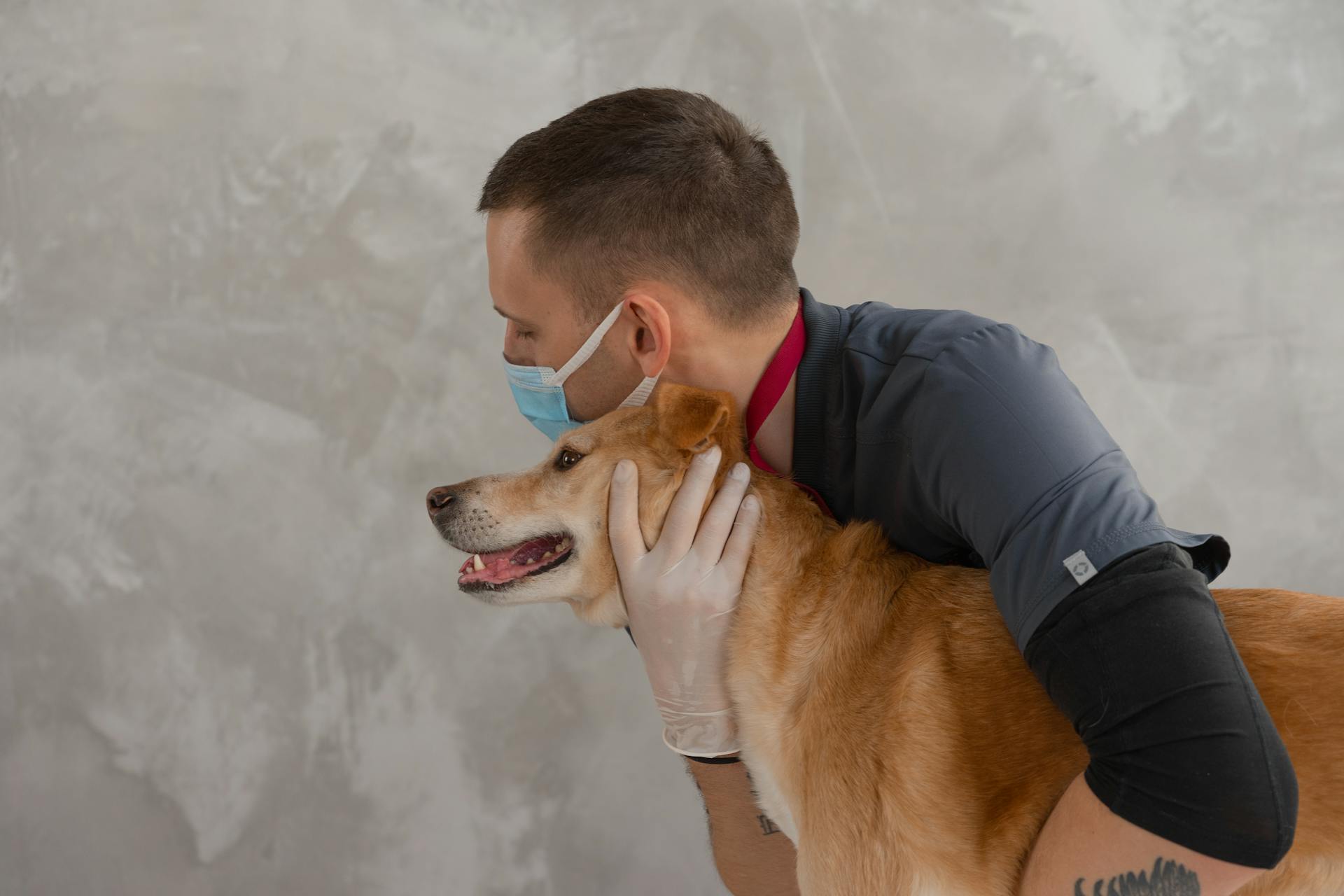
Spaying a female dog can have some significant side effects, but it's essential to understand what to expect. Some dogs may experience weight gain, which can be due to the reduced metabolism caused by the spaying surgery.
Dogs that gain weight after spaying often end up with a higher risk of obesity-related health issues. In some cases, this can lead to joint problems and other mobility issues.
A fresh viewpoint: Sudden Weight Gain in Female Dog
Potential Risks
Spaying a female dog can have some concerning side effects, particularly when it comes to certain types of cancer.
Mammary cancer is a significant risk for intact females, with 20% of predisposed breeds facing a lifetime risk of developing malignant mammary cancer.
Spayed females, on the other hand, have a significantly reduced risk of developing ovarian, uterine, or cervical cancer, making it essentially nonexistent.
However, spaying can actually increase the risk of certain malignant sarcomas, including lymphoma, osteosarcoma, and hemangiosarcoma.
In fact, spayed female Rottweilers have a three to four times increased risk of developing osteosarcoma, while spayed female vizslas are nine times more likely to develop osteosarcomas.
The age at which spaying occurs can also play a significant role in the risk of developing certain cancers, with early spaying increasing the risk of lymphosarcoma and late spaying increasing the risk of hemangiosarcoma.
It's essential to consider these potential risks and discuss them with your veterinarian before making a decision about spaying your female dog.
Health Issues
Spaying a female dog can have some serious health consequences that aren't always discussed. Spaying has been linked to a 4-20% increase in incontinence and a 3-4 times higher risk of persistent or recurring UTIs (urinary tract infections).
The risk of developing rare urinary tract tumors also doubles with spaying. This is concerning, especially since many pet owners aren't aware of this potential side effect. I've seen it firsthand with some of my friends' dogs.
Spaying can also increase the risk of certain types of cancer. Specifically, it raises the risk of splenic and cardiac hemangiosarcoma by a factor of 2.2 and >5, respectively. This type of cancer is among the top causes of death in some breeds.
Research is also showing that spaying young females significantly increases the risk of osteosarcoma (bone cancer), a common cancer in larger breeds with a very poor prognosis.
It's essential to consider these potential health issues when deciding whether or not to spay your female dog.
If this caught your attention, see: What Breed of Dog Has the Most Health Problems
Behavior and Spay/Neuter
Spaying a female dog can have a significant impact on her behavior.
Some dogs may become more relaxed and less anxious after spaying, especially if they were previously experiencing heat-related stress or anxiety.
Spaying can also reduce undesirable behaviors such as roaming in search of a mate, spraying, or mounting other animals.
However, some spayed dogs may become more prone to obesity, which can lead to a range of health problems.
According to studies, spayed dogs are at a higher risk of developing certain health issues, such as urinary incontinence or certain types of cancer.
Post-Procedure Care
After spaying your female dog, it's essential to follow a specific post-procedure care routine to ensure a smooth and safe recovery. Your dog may feel nauseated or tired due to the anesthetic, but pain medications will help ease the discomfort.
You can expect your dog's appetite to be lower for the first 24 hours after the procedure. To avoid licking the incision site, your dog will need to wear a cone, and you should not bathe or allow them to swim for at least 10-14 days. This will help keep the wound dry and promote healing.
Consider reading: Dog Names Female Start with S
Limiting your dog's activities and ensuring they get enough rest is crucial during this period. Even if they try to run or jump, it's essential to restrict their movements, as dogs don't understand the importance of rest. Keep your pup in their crate or a small room away from any excitement to limit their movements.
The recovery time for a spayed female dog is approximately 10-14 days, similar to that of a neutered male dog. During this time, it's essential to keep their cone on, the incision site dry, and their activities limited until they make a full recovery.
Here are some signs of complications to watch out for:
- Lethargy for more than a couple of days
- Refusal to eat more than a couple of meals
- Signs of pain for longer than a week (shaking, hiding, drooling)
- Acute redness, swelling or bruising at the incision site
- Bleeding or pus from the incision site
- Vomiting or diarrhea longer than 24 hours after the procedure
- The incision site reopens
- A bad smell coming from the incision site
If you notice any of these symptoms, contact your veterinarian as soon as possible.
Frequently Asked Questions
What is the best age to spay a female dog?
For optimal health and reduced cancer risk, spay your female dog between 6 to 9 months of age, ideally before her first heat cycle. This age range is recommended to minimize the risk of mammary cancer and other health issues.
Is it healthy for a female dog to be spayed?
Spaying a female dog can significantly reduce the risk of certain cancers and lead to a longer, healthier life. Learn more about the benefits of spaying and how it can improve your dog's overall well-being
Sources
- https://journal.iaabcfoundation.org/spay-and-neuter-surgery-effects-on-dogs/
- https://www.petplay.com/blogs/tips/what-are-the-side-effects-of-spaying-a-dog
- https://drdeeblanco.com/blogs/news/do-you-fear-the-side-effects-of-spaying
- https://healthyandhappydog.com/behavioral-effects-of-spay/
- https://www.frontierpet.com/site/blog/2023/12/15/signs-infection-spaying-neutering-dog
Featured Images: pexels.com


